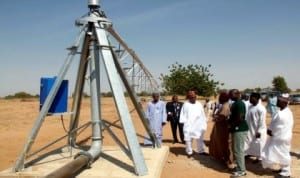Oil & Energy
Iran To Receive Frozen Oil Money, Feb 1 …As Agreement With World Powers Begins, Today

Governor Kashim Shettima of Borno State (3rd-left),inspecting a unit of Centre Pivot Irrigation Equipment, being installed by an American Agro Firm at a farm site on Maidugurikonduga Road under the gricultural transformation programme recently. The unit moves in circle to water crops in dry Season. Photo: NAN
Oil revenue money that
had been frozen under international embargoes is set to start flowing to Iran from February 1, 2014, with a target to cap its nuclear programme.
The Tide learnt that one of the states, Tehran, would receive a first payment of 550 million dollars.
An Senior U. S. Administrator, said that the total of 4.2 billion dollars were to be handed over in six months payments to the concerned parties.
In Brussels, the European Union, has promised it would fulfill its promise to partly lift sanction on Iran as part deal.
According to the EU foreign policy chief, Catherine Ashton, the EU sticks to its comments when it concerns sanctions and take all the necessary steps.
Ashton, who spoke through her spokeswoman, Maja Kocijancic, noted that all moves in that direction must be followed, so that what was agreed would also be fulfilled.
Our reporter also gathered that the agreement between Iran and the six World Powers would commence today Monday, January 20, 2014, when Tehran is to start rolling back parts of its nuclear programme.
Meanwhile, the Iranian Deputy Foreign Minister, Abbas Aragchi, has said that those talks could begin in two to three weeks, adding that the venue is not yet decided.
Oil & Energy
FG, MEMAN Chart Ways To Safe Petroleum Products Delivery

The Federal Government and key Petroleum Products marketers have proposed new measures to help curb rising cases of road accidents involving petrol tankers.
This followed recent incidents of road accidents resulting in cremation of hundreds of lives and causing extensive damage to properties.
Speaking at the Discourse organised by Mejor Energy Marketers Association of Nigeria (MEMAN) in Lagos, Thursday, with the theme “Improving Safe Transportation of Petroleum Products”, the Minister of State for Petroleum Resources (Oil), Heineken Lokpobiri, noted with dismay the number of casualties the country recorded recently due to tanker accidents.
Lokpobiri stressed the need for an enhanced training for tanker drivers, installation of detection leak devices as well as other safety systems that can assist drivers.
He called on Marketers and Federal Road Safety Commission (FRSC) to strengthen collaboration with stakeholders, especially in the training of tanker drivers.
On his part, the Minister of State for Petroleum Resources (Gas), Ekperikpo Ekpo, reaffirmed government’s commitment to providing enabling environment to ensure safety of petroleum products transportation.
Ekpo, who was represented by Engr. Abel, said consideration should be given to more safety means of transporting products like the pipelines and railway line.
He stressed the need for better training for drivers and implementation of safety regulations within the industry.
Earlier, Chairman, MEMAN, Huub Stokman, said the Association has elaborate training manual for members truck drivers.
Stokman insisted that more training programmes and consistent adherence to safety measures would help to curb road accidents involving tanker drivers.
Also speaking, the National President, Nigerian Association of Raod Transport Owners (NARTO), Yusuf Lawal Othman, called for support.
Oil & Energy
Benue To Pioneer Gas Production From Coal – NGEP

The Chairman, National Gas Expansion Programme (NGEP), Prof. Mohammed Ibrahim, has said that the production of coal bed methane, an unconventional form of natural gas extracted from coal, is set to begin in Benue State.
Prof. Ibrahim staed this while addressing newsmen at the end of a joint meeting of the National and State gas expansion committees with Benue State Governor, Hyacinth Alia.
He said the Federal Government is committed to expanding gas availability in Nigeria for domestic use and mobility.
Ibrahim added that extracting gas from unconventional coal sources rather than traditional hydrocarbon reserves is a way to boost gas availability.
“Essentially there are four areas of implementation that the committee has identified. One is to pioneer the production of gas from what you call coal bed methane, which means that Benue is going to pioneer in the country the production of gas not from conventional hydrocarbon, but from non-conventional coal just so that the nation will have an alternative source to gas availability”, he said.
Also speaking, the Chairman, Benue State Gas Expansion Programme, Dr. Emmanuel Chenge, said the gas expansion initiative would contribute to the economic transformation of Benue State.
“The good news is that Benue is set to join the league of gas-producing states and if we are conversant with what being a member of the gas-producing state is, it shows that Benue State will start getting derivatives from that sector of the economy”, Dr Chenge stated.
The National Gas Expansion Programme (NGEP) was established to boost the exploration and utilisation of gas in Nigeria and make Nigeria a gas-based industrial nation by increasing the use of gas for transportation, cooking, and industrialization.
Oil & Energy
NNPC Debunks Explosion Claim In Warri Refinery

The Nigeria National Petroleum Company Limited (NNPCL) has said there was no explosion at the newly refurbished Warri Refining and Petrochemical Company (WRPC).
NNPCL’s Chief Corporate Communications Officer, Olufemi Soneye, made this known in a statement issued on Friday night.
Soneye said reports claiming that there was an explosion at the Warri refinery were false and should be ignored and disregarded by the public.
According to him, the refinery was undergoing routine maintenance.
His statement read, “NNPC Ltd. wishes to clarify that there was no explosion at the Warri Refining and Petrochemical Company (WRPC). Any reports suggesting otherwise are completely false.
“On January 25, 2025, operations at WRPC Area 1 were intentionally curtailed to carry out necessary intervention works on select equipment, including field instruments that were impacting sustainable and steady operations.
“These intervention works are essential to ensure the production of on-specification finished and intermediate products, particularly Automotive Gas Oil (AGO) and Kerosene (Kero).
“The routine maintenance is progressing as planned, and Area 1 will be back in operation within the next few days.
“Despite ongoing interventions, over the past 11 days, AGO loading has been maintained at an average of eight trucks per day, with a sufficient supply available to sustain ongoing truck load-out operations”.
Soneye added that the NNPCL was committed to ensuring an uninterrupted supply of petroleum products from the refinery.
He said the company “appreciates the patience and cooperation of all stakeholders as it completes these essential maintenance activities”.
-
Sports5 days ago
Former President Kicks Off New Bayelsa Stadium Project
-
Business5 days ago
NESGAS, Cakasa Sign Deal For 50,000MT LPG Storage Facility In Rivers
-
Rivers5 days ago
Redeem Your Financial Pledges, Oxfam Urges Nations
-
Opinion5 days ago
Leveraging On Manpower Dev: Tai LG Model
-

 Politics5 days ago
Politics5 days agoN’Assembly Adjusts 2025 Budget, Raises Recurrent Expenditure
-
Sports5 days ago
Amuneke Lauds Super Focused Heartland
-
Business5 days ago
Total Energies Urges Right Policies, Environment To Attract Foreign Investors
-
Rivers5 days ago
Association Boss Urges For Professionalism, Efficiency Among Memebers

